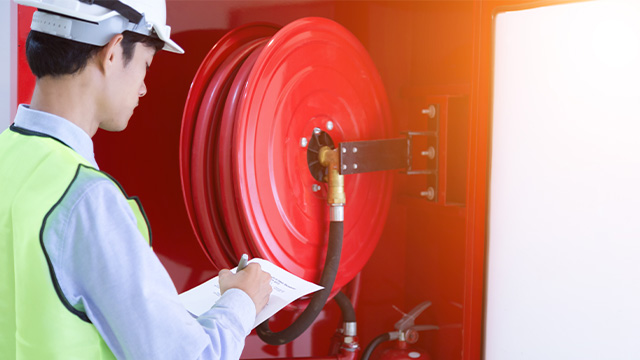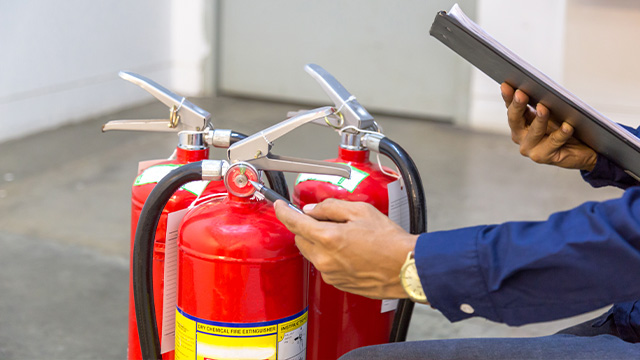Fire safety is an indispensable aspect of any workplace, as it protects lives and safeguards businesses from catastrophic losses. In Australia, fire is an enduring hazard that tragically results in around 100 fatalities and over 3000 injuries yearly. Therefore, understanding and implementing effective fire safety measures are paramount. This comprehensive guide provides valuable insights into the strategies and precautions necessary to ensure workplace fire safety.
What is Fire Safety?
Fire safety refers to protecting property, people, and assets from fire risks and hazards. It can involve a range of preventative measures, such as using working smoke alarms, flammable material storage guidelines and adhering to electrical safety standards. Fire safety also encompasses emergency response plans for evacuating employees during a fire outbreak or power outage.
Examples of Fire Incidents
- Overloaded electrical circuits: Overloaded electrical circuits can cause overheating and fires in homes and workplaces. This can occur when multiple appliances or devices are connected to a single circuit, surpassing its capacity.
- Faulty electrical equipment: Faulty electrical equipment, such as frayed wires, damaged plugs, or malfunctioning appliances, can pose a fire hazard. These issues can result in electrical sparks or short circuits, igniting nearby flammable materials.
- Flammable materials: Improperly stored flammable materials, such as chemicals and aerosols, can increase the risk of fire. These substances require special handling to ensure safe storage and minimise the possibility of ignition.
- Smoking: Carelessly discarded cigarette butts are one of Australia's leading causes of fires. Smoking policies should be strictly enforced in workplaces, with no-smoking areas indicated.
- Bushfire smoke: Bushfires can pose health and safety risks to workers, particularly those who work outside or near bushfire-prone areas. Smoke can affect workplaces, and failing to manage bushfire smoke risks can breach work health and safety laws.Bushfire smoke can directly challenge human health through its effects on respiratory and cardiac function, but it can also indirectly affect health.
- Hot work activities: In October 2022, a severe fire and explosion incident occurred during hot work activities at an engineering workplace, resulting in a worker suffering severe burns to his upper body. Activities like welding or grinding can quickly cause fires if safety precautions aren't followed.
- Electrically caused wildfires: In some cases, fires caused by faults in electricity distribution infrastructure have been observed, particularly during periods of elevated fire danger.
Impact of Fires
Economic Impact
Bushfires are one of Australia's most damaging natural disasters, with an estimated economic cost of around $2.5 billion each year. The fires have burned an area larger than Belgium, leading to significant damage and financial loss. They have also affected consumer confidence and tourism, potentially dragging down the economy.
Direct Damage to Properties and Businesses
Fire incidents can cause substantial direct damage to infrastructure and businesses. This damage includes the immediate destruction caused by fire to buildings, equipment, and inventory for companies and disruption to vital sectors such as transportation, communications, and power for infrastructure.
Environmental Impact
The environmental hazards resulting from fire incidents can be immense. Fires contribute to air pollution as smoke and other toxic particles are released into the atmosphere, leading to adverse health effects. They also destroy habitats for flora and fauna, resulting in an ecosystem imbalance.
Human Cost
Aside from the economic and environmental losses, fires can also result in significant human costs. The death toll from fires is unacceptably high, and the psychological impacts of fires can be severe, particularly for survivors and those affected.

Legal Requirements for Fire Safety in Australia
In Australia, there are legal requirements for fire safety that businesses and individuals must comply with. Here are some of the key legal requirements for fire safety in Australia:
1. Compliance with Australian Codes
The building's fire safety system should be under Australian standards and any relevant building acts. Compliance with Australian construction, fire, signage, and electrical safety codes is essential for fire safety.
2. Annual Fire Safety Assessment
Effective from 1st July 2020, the Annual Fire Safety Assessment must be conducted by an accredited practitioner with Fire Safety Assessment (FSA) accreditation. According to Australian law, a fire risk assessment must be conducted in all workplaces to ensure adherence to fire safety regulations and measures.
3. Australian Standards
AS 3745-2010 outlines the essential criteria for developing, assessing, and executing an emergency plan at a facility. Its objective is to ensure the safety of occupants during any emergency.
Key requirements of AS 3745-2010 include:
- Emergency Planning Committee (EPC): A team entrusted with the responsibility of creating and upholding the emergency plan.
- Emergency Control Organisation (ECO): A group of trained people who will respond to an emergency per the emergency plan.
- Emergency Response Procedures: These are procedures for specific situations that may arise during an emergency.
- Training: The Standard requires regular training and exercises for the ECO to ensure they can carry out the plan effectively.
- Evacuation Diagrams: AS 3745-2010 outlines the necessary specifications for evacuation diagrams. It is imperative that any individual or entity operating a business or facility possesses these essential diagrams.
- Specialised Equipment Use: The Standard also specifies the use of specialised equipment pre- and post-emergency.
Here are some of the key Australian Standards for fire safety:
- AS 1851 – 2012 Routine service of fire protection systems and equipment: This standard specifies the requirements for the routine service of fire protection systems and equipment, including fire detection and suppression systems.
- AS 1670 - Fire detection, warning, control and intercom systems: This standard outlines requirements for designing, installing, and maintaining fire detection, warning, control, and intercom systems.
- AS 1603 - Automatic fire sprinkler systems: This standard outlines the criteria for designing, installing, and maintaining automatic fire sprinkler systems. It ensures that these systems meet the highest standards of safety and effectiveness.
4. Safety Signage Requirements in Australia
Compliance with signage codes is essential for fire safety in Australia. The signage codes for fire safety are primarily governed by the Australian Standard AS 1319 - Safety Signs for the occupational environment. This standard provides guidelines for designing, placing, and using safety signs in workplaces and other occupational environments to communicate hazards, warnings, and emergency information effectively.
Design requirements:
- Safety signs should have a recognisable shape, colour, and symbol to convey their meaning effectively.
- The design should be clear, concise, and easily understood.
- The size of the sign should be appropriate for the viewing distance and the information it conveys.
Sign categories:
- Prohibition signs: Indicate actions or behaviours that are prohibited.
- Warning signs: Warn of potential hazards or dangers.
- Mandatory signs: Indicate actions or behaviours that are required.
- Emergency information signs: Information about emergency facilities, equipment, or exits.
Sign colours:
- Prohibition signs: Red circle with a diagonal line on a white background.
- Warning signs: Yellow or amber background with black symbols or text.
- Mandatory signs: Blue background with white symbols or text.
- Emergency information signs: Green background with white symbols or text.
Sign placement and visibility:
- Signs should be positioned to ensure maximum visibility and legibility.
- They should be located in areas where the hazard or information is relevant.
- Signs should be well-maintained and free from obstruction.
Why Is Fire Safety Important?
Given the disastrous impacts of fire-related incidents, it is critical to implement adequate safety protocols in workplaces and homes. Doing so can help reduce the risk of fire outbreaks, minimise losses from potential fires, and create a safe environment for all.
Benefits of Fire Safety Preparedness
- Protection of Life: The most crucial reason for fire safety is to protect human life. Fires can cause serious injuries or fatalities.
- Property Protection: Fires can cause significant damage to buildings and contents. Ensuring fire safety helps protect your property against such damage.
- Business Continuity: For businesses, a fire can lead to operational disruption, loss of revenue, or even permanent closure. Fire safety measures can help ensure business continuity.
- Legal Compliance: In many regions, fire safety is a legal requirement. Failure to comply can result in fines or imprisonment.
- Insurance Requirements: Many insurance companies require businesses to have specific fire safety measures. Failure to do so may invalidate insurance policies.
- Protection of Environment: Fires can release harmful pollutants into the environment. Fire safety measures can help prevent environmental damage.
- Preventing Spread to Adjacent Properties: A fire can quickly spread to nearby buildings, causing widespread damage. Effective fire safety measures can help contain and prevent a fire from spreading.
- Preservation of Jobs: In the case of commercial establishments, fires can lead to job loss. Fire safety can help protect livelihoods.
- Community Safety: Large fires can impact entire communities, not just individual homes or businesses. Fire safety helps protect the broader community.

Strategies to Ensure Fire Safety in the Workplace
1. Fire Risk Assessment
A Fire Risk Assessment is a systematic evaluation of the potential fire hazards within a facility or workplace. It aims to reduce the fire risk and ensure that people can safely escape if a fire occurs. Here's what you might typically include in a Fire Risk Assessment:
- Identification of Fire Hazards: This includes sources of ignition (such as electrical equipment), fuel sources (like flammable materials, chemicals, or waste), and sources of oxygen (such as air conditioning systems).
- Determination of People at Risk: Identify who may be at risk in the event of a fire. This includes employees, visitors, contractors, and anyone who may be particularly vulnerable, such as people with disabilities or those working alone.
- Evaluation of Risks: Evaluate the level of risk presented by the identified hazards. Consider the likelihood of a fire starting and the potential impact if one were to occur.
- Record of Findings: Document your findings. This should include the identified hazards, the people at risk, your evaluation of the risks, and any fire safety measures currently in place.
- Fire Prevention Measures: Identify measures to eliminate or reduce the risk of a fire starting. This could include safe storage of flammable materials or regular maintenance of electrical equipment.
2. Preventive Measures for Fire Safety
Proper storage of flammable materials
Proper storage and handling of flammable substances is essential for fire safety. These substances must be stored in a designated safe area, away from sources of heat or ignition. All containers must be clearly labelled with the type of substance inside them.
Regular inspection and maintenance of electrical equipment
Regular inspection and maintenance of electrical equipment, following the manufacturer's instructions and specifications, is imperative to ensure optimal functionality and longevity.This includes checking for exposed wires, loose connections, or other signs of wear and tear. Where necessary, repairs should be carried out by a qualified electrician.
Fire safety training for employees
All employees must be trained on fire safety procedures. Several registered training organisations offer training in compliance with Australian standards and regulations. The training should include:
- Understanding Fire Hazards: Employees must be aware of potential fire risks in their work environment, the different types of fire hazards, and their prevention.
- Emergency Evacuation Procedures: Training should cover the company's evacuation procedures or fire escape plan, including designated exit routes, fire stairs, and assembly points.
- Using Fire Fighting Equipment: Approximately 50% of individuals who handle a fire extinguisher do so incorrectly or dangerously. Employees must then receive proper training on the correct usage of fire extinguishers and other firefighting equipment.
- First Aid Training: Basic first aid training, including how to treat burns, can be essential to fire safety training.
- Fire Warden Training: Some employees may be designated fire wardens with additional responsibilities during a fire emergency. Fire wardens need practical training to fulfil these roles effectively.
- Fire Safety Legislation: Employees must understand the relevant Australian fire safety legislation and standards, such as the Australian Standard AS3745-2010.
- Fire Prevention Strategies: Employees should be aware of strategies to prevent fires, such as maintaining a clean and organised workspace, proper handling and storage of flammable liquids, and safe electrical practices.
- Responding to Fire Emergencies: Training should cover how to react if a fire does break out, including raising the alarm, contacting the fire department, and evacuating the building.
- Regular Fire Drills: Regular fire drills can help ensure that employees understand and can effectively follow fire safety procedures.
- Risk Assessment: Training should also include information on conducting a fire risk assessment, which involves identifying potential fire hazards and deciding how to manage them.
No smoking policies
Smoking is one of the leading causes of workplace fires and should be strictly prohibited in all workplace areas. Designated smoking areas should be provided outside, away from buildings or combustible materials.
3. Fire Safety Plan
A Fire Safety Plan is a comprehensive strategy designed to ensure the safety and health of people in the event of a fire. It ensures that buildings and facilities meet Australia's necessary fire safety standards and regulations. The components of a fire safety plan may vary depending on the jurisdiction. However, in general, it should include the following:
1. Routine service of fire protection systems:
- Compliance with AS 1851 – 2012
- An inventory list of fire prevention equipment and who is responsible for maintaining them
- A schedule for ensuring that crucial fire protection systems, such as fire alarms, are in working order in case of an emergency
2. Fire safety management plan:
- Management and procedures to prevent fire from arising and protect the property and its occupier when a fire does happen.
- Information, instruction, and training should be adequate and well delivered to ensure the organisation's competence.
3. Compliance with Australian fire standards:
- Compliance with Australian fire standards, including electrical and signage requirements
- Compliance with local building codes, fire codes, and electrical safety codes
4. Emergency procedures:
- Procedures to be used in fire, including how to sound the alarm, notify the fire department and evacuate building occupants
- Guidelines for responding to emergencies that occur outside of regular business hours
5. Fire protection systems:
- A complete inventory of fire safety equipment.
- A schedule for ensuring that crucial fire protection systems, such as fire alarms, are in working order
6. Notifying and reporting:
- Methods for alerting occupants and reporting fires to the fire department or designated emergency response organisation, including preferred and alternative means of communication.
7. Plans:
- A site plan diagram highlighting the assembly point, fire exits, and other essential features
- A list of emergency services personnel and their duties during an emergency

Fire Safety Preparedness With SafetyDocs
Fire safety is not a one-time task but an ongoing responsibility. You need the appropriate tools and resources to maintain a safe working environment. SafetyDocs by SafetyCulture, Australia's most trusted and leading provider of safety documents, is your one-stop shop for safety documents and resources.
We provide ready-made, customisable templates, checklists, plans, and forms to help you comply with local regulations and protect your workplace from fire hazards. Expert health and safety practitioners create our safety documents in compliance with the latest Australian standards. To start becoming prepared, check out the following documents as a starting point:
- Fire Prevention and Safety Safe Operating Procedure
- Emergency Response Procedure - Fire
- Fire Detection-Alarms Testing Safe Work Method Statement
- Fire Extinguisher Installation - Maintenance Safe Work Method Statement.
- Emergency Response Plan
Be sure to get ready before something happens. Get started on fire safety preparedness today with SafetyDocs. Contact us to learn more about our safety documents and services.
Our team of experts is dedicated to providing accurate and informative content. Craig Cruickshank, our senior HSEQ advisor at SafetyDocs by SafetyCulture has reviewed this blog post to ensure the highest level of quality.
Learn more about Craig's work on LinkedIn for more industry insights.
Available for instant download and supplied in fully editable MS Word format for use in your business.
Please note that the above information is provided as a comment only and should not be relied on as professional, legal or financial advice.
Share This Article
